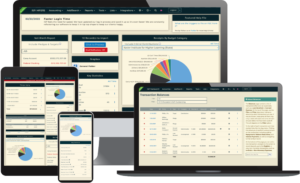One of the many Financial reports you can generate is the Transactions report. This report allows you to view and export transactions in your database with advanced filtering and selection criteria.
In the Search section are various fields and menus to narrow or broaden the results. To the right in the section header is a dropdown to add different search options. These include:
- Transaction Type: Choose one or more transaction types
- Transaction Tag: Choose one or more transaction tags
- Transaction Method: Choose one or more transaction methods
- Budget Category: Choose one or more budget categories
- Election: Choose one or more elections
- Financial Accounts: Choose one or more financial accounts
- Entity Types: Choose one or more entity types
- Events: Choose one or more events
- Amount Range: Use a range of dates to narrow your search
- Compliance Note Is/Contains: Use this field to find results that is all of or contains the text in a compliance note
- Internal Note Is/Contains: Use this field to find results that is all of or contains the text in an internal note
- Check Note Is/Contains: Use this field to find results that is all of or contains the text in a check note
- Advanced Searches: Locate results from one of your saved Advanced Search templates
- Creator: Narrow your results by the creator of a transaction
- Editor: Narrow your results by the editor of a transaction
To the right of each option is a red X, which will simply remove them from view and place them in the Add dropdown.
If you are searching by Date, you can click the field name and choose from four different Date type options.
- Transaction Date: This is the date used for the transaction.
- Whole Date: This is the date of the transaction’s whole, if it is a non-deposit split.
- Creation Date: This is the date the transaction was created in your database. This can often be different than the date of the transaction.
- Edit Date: This is the date if the transaction was edited at any time.
Towards the bottom of the Search section are Split and Memo Handling options. These allow you to include or exclude Splits and Wholes, as well as Memos and Non-Memos.
Another search option is the Reported Handling trio of choices. Use these to filter results by whether they’re on a report marked as filed or not. Please note the option for Reported will only provide results that are itemized transactions and not included in any aggregates.
Use the Deposited filter to narrow your results down to whether or not transactions are in a deposit batch, not in a deposit batch, or both in a batch and outside of one.
After you’ve chosen the criteria for the report, you can then determine what specific columns of information you’d like to see, including sorting the data or aggregating transaction totals.
In the Display section is your option field for Columns. These are how your data will display on the screen, as well as export to a spreadsheet.
The Columns section contains all the ways to display the data, ranging from basic info like Amount and Date to more complex or in-depth data, such Allocation or Transaction Tags, if applicable.
It’s important to note that some Column options, such as All Emails and All Phones, take the system longer to sort through, which can cause the report generation time to be a little longer than usual. If the report is large enough, our system will generate it in the background and email it to you. If you don’t see the email, check your spam folder. If it’s not there either, it’s possible your email provider blocks larger emails. Contact your email provider’s IT person for assistance.
There are three fields that, while similar, can affect your report totals in different ways:
- Amount: the raw amount of the transaction.
- Net Worth Impact: the transaction’s impact on the organization’s net worth.
- Cash Impact: the transaction’s impact on the organization’s cash.
These fields will have different numbers based on the nature of the transaction. For example, a $500 expense would have values of:
- Amount: $500
- Net Worth Impact: -$500
- Cash Impact: -$500
An Inkind Contribution of $200 would have values of:
- Amount: $200
- Net Worth Impact: $0
- Cash Impact: $0






